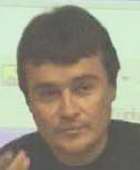1- Dalgacıklar ve Bunların İşaret ve Görüntü İşleme Uygulamaları Bilkent Üniversitesi'nden Prof.Dr. A. Enis Çetin tarafından, "Dalgacıklar ve Bunların İşaret ve Görüntü İşleme Uygulamaları" başlıklı bir eğitim semineri verilecektir. Seminerin detayları daha sonra duyurulacaktır.
Bilkent Üniversitesi'nden Prof.Dr. A. Enis Çetin tarafından, "Dalgacıklar ve Bunların İşaret ve Görüntü İşleme Uygulamaları" başlıklı bir eğitim semineri verilecektir. Seminerin detayları daha sonra duyurulacaktır. |
2- Sınıflandırıcılarda Hata Ölçülmesi ve Karşılaştırılması için İstatistiksel Yöntemler Boğaziçi Üniversitesi'nden Prof.Dr. Ethem Alpaydın tarafından, "Sınıflandırıcılarda Hata Ölçülmesi ve Karşılaştırılması için İstatistiksel Yöntemler" başlıklı bir eğitim semineri verilecektir.
Boğaziçi Üniversitesi'nden Prof.Dr. Ethem Alpaydın tarafından, "Sınıflandırıcılarda Hata Ölçülmesi ve Karşılaştırılması için İstatistiksel Yöntemler" başlıklı bir eğitim semineri verilecektir. |
3- Gelecek Nesil Kablosuz Algılayıcı Ağları Orta Doğu Teknik Üniversitesi'nden Doç.Dr. Özgür B. Akan tarafından, "Gelecek Nesil Kablosuz Algılayıcı Ağları" başlıklı bir eğitim semineri verilecektir. Seminerin detayları daha sonra duyurulacaktır.
Orta Doğu Teknik Üniversitesi'nden Doç.Dr. Özgür B. Akan tarafından, "Gelecek Nesil Kablosuz Algılayıcı Ağları" başlıklı bir eğitim semineri verilecektir. Seminerin detayları daha sonra duyurulacaktır. |
4- Multihop Mesh Networks And Cooperative Communications Carleton Üniversitesi'nden Doç.Dr. Halim Yanıkömeroğlu tarafından, "The New Wireless Radio Access Network Paradigm: Multihop Mesh Networks And Cooperative Communications" başlıklı bir eğitim semineri verilecektir. Seminerin detayları daha sonra duyurulacaktır.
Carleton Üniversitesi'nden Doç.Dr. Halim Yanıkömeroğlu tarafından, "The New Wireless Radio Access Network Paradigm: Multihop Mesh Networks And Cooperative Communications" başlıklı bir eğitim semineri verilecektir. Seminerin detayları daha sonra duyurulacaktır. |
5- Empirical Mode Decomposition: an adaptive approach to analyze non-linear
time series
 Dr. Paulo Gonçalves Dr. Paulo Gonçalves
Empirical Mode Decomposition is a recent technique (N. E. Huang et al.,
1998) introduced to analyze non-stationary and non-linear time series in a
totally adaptive way. In contrast to standard kernel based approaches (e.g.
wavelet decompositions), EMD is a fully data-driven method that recursively
decomposes a complex signal into a variable but finite number of zero-mean
with symmetric envelopes AM-FM components called Intrinsic Mode Functions
(IMF). [To proceed, an iterative algorithm locally identifies in the signal the
fastest oscillations and isolates them in the first IMF. Each successive IMF is
then obtained iterating the same sifting process on the remaining lower trend.]
This appealing analyzing tool is reversible by construction, and gives rise to
a
natural "scale" decomposition that goes beyond classic spectral analysis
and its
Fourier modes.
After a schematic presentation of the algorithm, we will address some of its
technical issues and report on the major EMD weakness, that is the lack of a
theoretical framework to support the method and to analytically characterize
an IMF.
To finish, we will present an EMD application to satellite time series imagery
for land cover classification. This simple study will not only illustrate the
flexibility of this non parametric method but also show, by comparison with
model-based identification procedures, the EMD ability at retrieving non-linear
modes.
|

